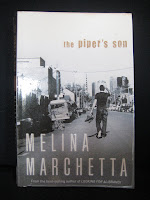From the book’s website, the story goes like this:
In a single moment, everything changes. Seventeen-year- old Mia has no memory of the accident; she can only recall riding along the snow-wet Oregon road with her family. Then, in a blink, she finds herself watching as her own damaged body is taken from the wreck... A sophisticated, layered, and heart achingly beautiful story about the power of family and friends, the choices we all make—and the ultimate choice Mia commands.If I Stay has music as its background theme, with Mia a talented cello player, her father once the guitarist in a band, and her boyfriend, Adam, is a lead singer and guitarist with an up and coming band. The book reminds me of the style of Alice Sebold’s Lovely Bones, the story being told by one of the characters existing outside her physical body, and who can see the events unfolding but unable to influence it. The story is told in flashbacks of the important event’s in Mia’s life: being brought up by an extended family of musicians as her family travels with her father’s band to gigs, the birth of her younger brother Teddy being the impetus for her father to learn to drive and train as a secondary schoolteacher, meeting her best friend Kym, her first date with Adam and moving on to the next stage with him, and her audition to get into the Julliard School of Music in New York.
This is a story that revolves around the choices we have to make in life. Her father’s chose the more family orientated life of a school teacher, rather than continue travelling with his band and, at the time of the accident, Mia was considering whether she would have to make the choice between moving to New York to attend school or to stay where Adam is in Portland. Now, her more important choice is whether she can live with the devastation that the car accident has caused.
I polished the book it off in a few days and it did require reading with a box of tissues next to me, so I’m sure that some adults would find it as beautiful read as I did. I think that secondary college students would get a lot out of it and could be the basis of discussion on the effects of death on the people left behind, the concept of choice and that often there is no right or wrong answer, and the importance of family and friends in everyone’s life. However, the level of description of the car accident, a quite detailed relationship scene and the concept of deciding whether she has anything to stay for on earth, would make me say that it is not for younger readers.






